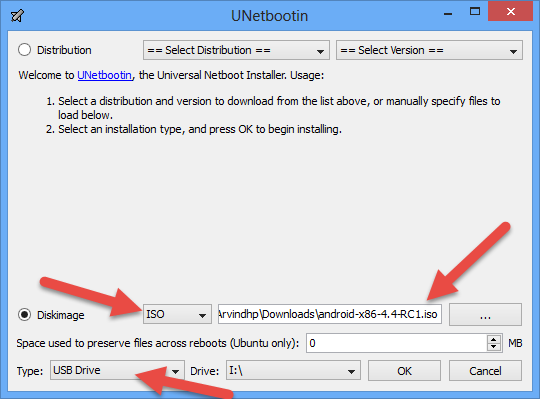
- UNETBOOTIN ANDROID 4.4 HOW TO
- UNETBOOTIN ANDROID 4.4 INSTALL
- UNETBOOTIN ANDROID 4.4 UPGRADE
- UNETBOOTIN ANDROID 4.4 ISO
- UNETBOOTIN ANDROID 4.4 FREE
After restarting your computer you will be given the option to choose the operating system you want to run, Windows or Android.
UNETBOOTIN ANDROID 4.4 INSTALL
This all and you had the chance to install Android 4.4 Kit-Kat on your PC easily.
Now, with another message you will be asked to set the System / r / w, so that the read / write unit of the PC is placed in the first place.Choose S. If something appears in relation to GRUB Bootloader appears, leave it. Choose the partition to install on Android x86, if you use a new partition it is better to format it first. In the menu select Install x86 for Hard Drive.  Now restart the PC system and choose USB as the default boot drive, all the latest BIOS have this option.
Now restart the PC system and choose USB as the default boot drive, all the latest BIOS have this option. UNETBOOTIN ANDROID 4.4 ISO
Download the ISO file and create a bootable USB drive or use UNetbootin. UNetbootin (downloadable here) A USB stick with 1GB or more of storage space (I used an 8GB. thats suitable for your computer hardware, and UNetbootin tool for flashing. UNETBOOTIN ANDROID 4.4 HOW TO
How to install Android 4.4 Kit-Kat on your PC The Android-x86 4.4-r4 is based on the 4.4-r3 release. My other Android remaster KitKat 4.4.4 Build 180108 will run also on older.
UNetbootin for creating bootable USB drives or burning ISO images to USB Flash Drive with ISO to USB. UNETBOOTIN ANDROID 4.4 FREE
Free space on Hard Drive, Kit-Kat needs 10GB. Appropriate Downlaod of ISO Androidx86: link. Once you’ve partitioned your hard disk using fdisk command, use mke2fs to create either ext2, ext3, or ext4 file system.Ĭreate an ext2 file system: mke2fs /dev/sda1Īrul, I’m using tune2fs ext4 on Debian Wheezy 64-bit.Below you will find the guide on how to install Android on PC, but we must warn you that if something happens to the device during or after the process we assume no responsibility, the odds are rare, but our job is to remember it. You will lose your data! Creating an ext2, or ext3, or ext4 filesystem Warning: Don’t execute any of the commands given below, if you don’t know what you are doing. Use the method we discussed earlier to identify whether you have ext2 or ext3 or ext4 file system. In ext4, you also have the option of turning the journaling feature “off”. All you need to know is that these new features have improved the performance and reliability of the filesystem when compared to ext3. Several other new features are introduced in ext4: multiblock allocation, delayed allocation, journal checksum. UNETBOOTIN ANDROID 4.4 UPGRADE
You can also mount an existing ext3 fs as ext4 fs (without having to upgrade it). Directory can contain a maximum of 64,000 subdirectories (as opposed to 32,000 in ext3). Overall maximum ext4 file system size is 1 EB (exabyte). Maximum individual file size can be from 16 GB to 16 TB. Supports huge individual file size and overall file system size. Starting from Linux Kernel 2.6.19 ext4 was available. Ext4 stands for fourth extended file system. You can convert a ext2 file system to ext3 file system directly (without backup/restore). Metadata might be journaled either before or after the content is written to the disk. Writeback – Only metadata is saved in the journal. Metadata are journaled only after writing the content to disk. Ordered – Only metadata is saved in the journal. Journal – Metadata and content are saved in the journal. There are three types of journaling available in ext3 file system. Overall ext3 file system size can be from 2 TB to 32 TB. if you can could you please get me the right confi for getting connected. i checked network connections and did set right values with dhcp mode. 
When the system crashes, the possibility of file system corruption is less because of journaling. Internet connectivity post dsl 4.4 install - posted in UNetbootin: hi, i installed dsl 4.4 under unetbootin on a stick.
Journaling has a dedicated area in the file system, where all the changes are tracked. The main benefit of ext3 is that it allows journaling. Starting from Linux Kernel 2.4.15 ext3 was available. Ext3 stands for third extended file system. Overall ext2 file system size can be from 2 TB to 32 TB. Maximum individual file size can be from 16 GB to 2 TB. On flash drives, usb drives, ext2 is recommended, as it doesn’t need to do the over head of journaling. This was developed to overcome the limitation of the original ext file system. Ext2 stands for second extended file system. How to convert from one filesystem type to another. High level difference between these filesystems. Ext2, ext3 and ext4 are all filesystems created for Linux.






 0 kommentar(er)
0 kommentar(er)
